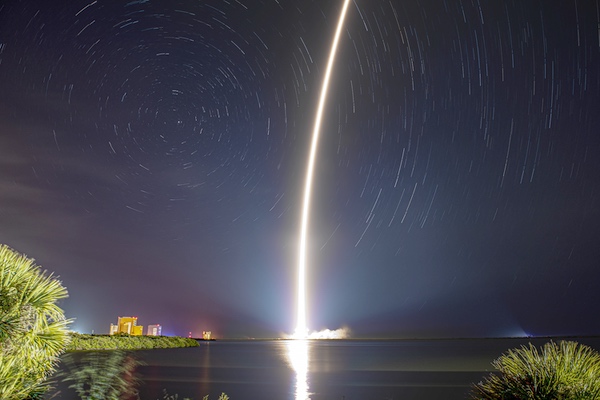Effect of upgrades to Starlink Generation 2 satellites on visual brightnessby Brad Young and Jay Respler
|
| Understanding the effects on all stakeholders requires two steps: measuring the evolving threats and monitoring the engineering mitigation for effectiveness. |
Specifically, the authors have concentrated their efforts on observing, reporting, and publishing data on the prototype Blue Walker 3 from AST Space Mobile and the still-growing OneWeb and Starlink constellations. The aim of this article is to present new observations of the initial Gen 2 Starlink satellites and discuss how their brightness is likely to contribute to the ongoing impact on optical astronomical observations.
On February 27, 2023, the first of the Gen 2 Starlink satellites was launched into orbit. This initial slate of 22 satellites were not the “final” version of the Gen 2 design, but a modified Gen 1 payload that was an interim step in design, referred to as Gen 1.5. Visual observations conducted after the group reached operational orbit suggested that these satellites would be particularly bright, as expected with a larger object compared to the Gen 1 design. They also had a blue color not seen previously, due to a new material selected by SpaceX specifically for reduction of optical brightness.
Background
Operators of these megaconstellations have begun to launch their satellites, ranging from prototypes to second generation designs. Understanding the effects on all stakeholders requires two steps: measuring the evolving threats and monitoring the engineering mitigation for effectiveness. SpaceX has the largest number of satellites in orbit currently and is the earliest major entrant. Early reports on the deleterious effects of their satellites on astronomy led to engineering changes in orbital parameters and design to reduce their reflectivity. With Gen 1—the original, smaller Starlink satellites—changes included orbital height adjustment, a visor (VisorSat), and special coating (DarkSat). This study looks at the reduction in optical brightness reached in the upgrade to Gen 2, where significant design changes were made to accommodate a larger object. A summary of the changes incorporated by SpaceX may be found here.
SpaceX is aware of the significant effect of solar phase angle on these long, flat satellites and instituted a policy of operating in a “shark fin” attitude that minimizes reflection of sunlight to Earth. However, this angle changes often throughout the orbit and must also adapt to any orbital changes. Many of the observed satellites that were suddenly bright on one pass were occasionally dim on a later pass with similar geometry, indicating the small room for error that this “knife’s edge” mode allows.
Methods
All the data used for this analysis is visual magnitude, determined by using the methods below. The observations were performed by:
- Jay Respler, a dedicated satellite observer who has logged hundreds of brightness reports on Starlinks and OneWeb payloads since the first launches.
- Brad Young, who has reported on 90% of the Starlinks in orbit and has seen more than 9,000 unique objects in orbit visually, resulting in over 40,000 reports.
Visual observations were undertaken from March 16 to July 25 of 2023 from sites near Tulsa, Oklahoma, and Monroe, New Jersey. In most cases, hand-held binoculars were used to perform visual observations, using the following procedure. First, pass predictions are obtained for the observer's site. At a minimum, the location, expected time of observation, and the limiting magnitude an experienced observer can reliably see must be known, bearing in mind that moving objects may appear dimmer visually. Observable passes at low elevation, in deep twilight, or at unfavorable phase angles are discarded.
Next, suitable comparison stars are chosen to provide brightness measurements. The timing, location, and brightness of newly launched satellites often differ significantly from available pass predictions. Sufficiently bright comparison stars to enable magnitude estimation are selected for the appropriate stage of twilight, and alternate stars chosen in case the satellite pass was off track or early/late. All comparison star magnitudes are from the extended Hipparcos catalog.
Finally, the objects are observed as they pass the selected comparison stars, so a direct comparison can be made and immediately recorded. Any significant brightness variation (flashing or flaring) was also recorded at that time. Although brightness variations are not used for determining standard magnitudes, they may still provide useful space situational awareness information.
Discussion
Initially, as with Gen 1 launches, the objects were quite bright, easily seen with the naked eye and as bright as magnitude +1. After a period of a few weeks and with more observations, many of the objects from the first launch were found to be dim. Eventually, many of the Gen 1.5 and especially the Gen 2 satellites were dimmed to the point where they could not be seen by a visual observer using binoculars.
However, continued observation showed that the dimness was not always permanent. Occasionally a payload would become naked-eye brightness again, and then return to dimness, or remain bright. Refer to Figures 1–4, which describe the observed corrected magnitude of the Starlinks Gen 1.5 and Gen 2.
| Despite many efforts by the aerospace industry, policymakers, astronomers, and the community at large, the trend to make substantially larger and brighter satellites seems to persist. |
The corrected magnitude is the apparent magnitude of the satellite, correcting the distance to 1,000 kilometers. Due to the complexity of modeling the shape of the Starlinks and unknown albedo and scattering behavior, a simpler model provides a way to compare differential brightness. No attempt is made to determine standard magnitude using phase angle; only range is considered. Therefore, this paper does not determine a standard magnitude for any of these satellites. Comparison to the target maximum brightness set by the International Astronomical Union (IAU) of magnitude 7.2 is based on the range corrected magnitude in this study. The light curve of the payloads in shark-fin mode are nearly flat across most of the pass through the sky, so this approximation should be acceptable for the purpose here.
With this approach, some trends in the behavior of the new generation satellites are shown. Whatever transitory changes were made with Gen 1.5, many of that set did not perform as well as the “true” Gen 2 payloads. Two graphs show the typical outcomes so far for Gen 1.5. Note that not all the observed satellites are included in the data, only enough to show the trends but remain readable. Also, a few of the ranges are estimates due to the short life of elements with initial orbital raising and the inherent lag in dissemination of elements for these objects.
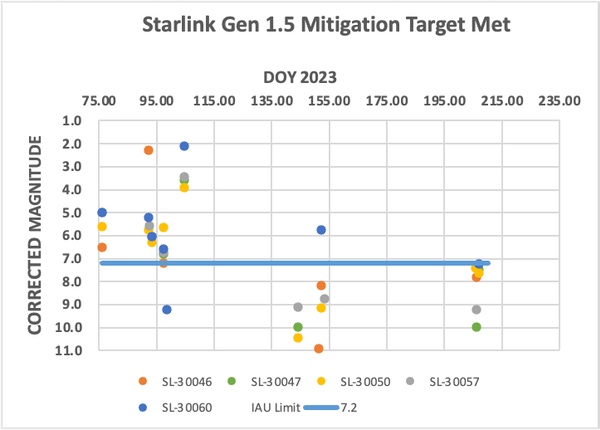 Figure 1 |
Gen 1.5 has several payloads that, as of July 30, 2023, have not met the criteria of a range-corrected magnitude of 7.2. The graph above shows examples of payloads successfully mitigated to the recommended parameter. The next graph shows examples of objects that, so far, have remained brighter than desired.
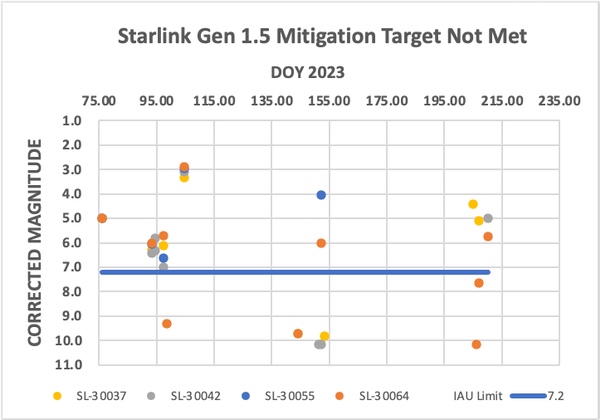 Figure 2 |
Gen 2 satellites have been more consistent in making the mag 7.2 mark; examples of these are shown in the third graph, and the last graph shows examples of the Gen 2 that did not meet it. The behavior of the satellites may indicate that the orbit modifications and positioning for Gen 1.5 were more elaborate than those needed to line out Gen 2. This may be indicative of an operator learning curve to maximize brightness reduction, or there may be reasons for this behavior that have little to do with brightness mitigation. It is an active situation: there are still many new Gen 2 groups that have had only a few observations. Those payloads are in the early stages of reaching final orbit and were not included here.
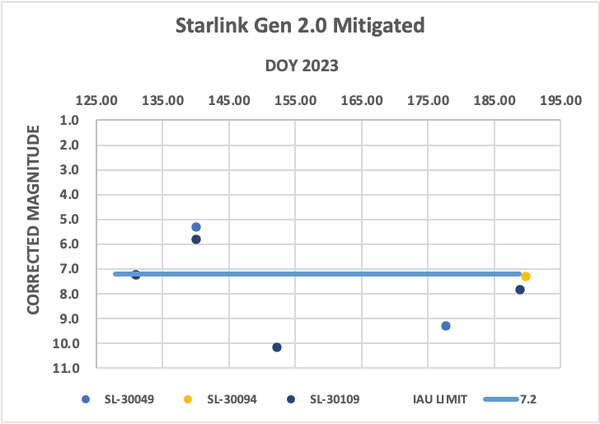 Figure 3 |
Further study is needed to determine what patterns emerge and what explanations may predict behavior. Monitoring by the astronomy community would be most efficiently accomplished by crowdsourcing the effort to amateurs. Although SpaceX has made great progress in reducing the brightness of a new, larger Starlink, we see already, through hundreds of observations, that there are still bright Gen 2 objects at final orbital height.
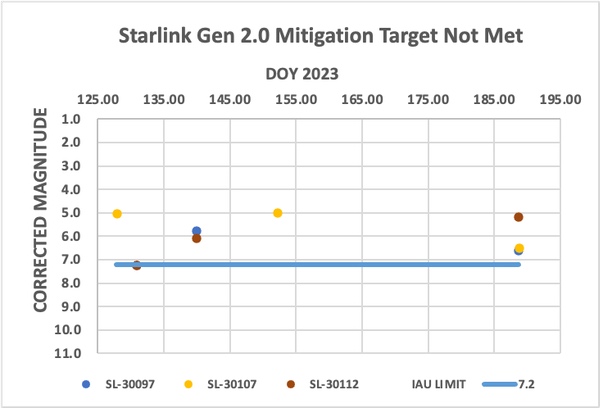 Figure 4 |
Path forward
The IAU recommendation is that the maintained brightness on-station of a satellite is not to exceed magnitude 7.2. Satellites such as Starlink Gen 2 could also present an additional source of noise for radio astronomy since radio quiet zones, in which radio telescopes operate, do not automatically limit satellite emissions. This can be a particular issue for telescopes like the NRO at Green Bank which observe at or close to frequencies normally used by devices served by satellites. The planned constellation of thousands of such satellites over the next decade may necessitate more research into effective strategies to protect upcoming ground-based telescopes and surveys such as the Extremely Large Telescope (ELT) or the Vera C. Rubin Observatory's Legacy Survey of Space and Time (LSST).
Despite many efforts by the aerospace industry, policymakers, astronomers, and the community at large, the trend to make substantially larger and brighter satellites seems to persist. Regulatory intervention could help ensure operators critically assess the impact of their satellites on the space environment before launch.
Communication with SpaceX confirmed that mitigation had included both design modifications to the satellites (the final Gen 2 set), and changes in attitude and other spatial adjustments after orbit was achieved. In a few cases, signal to the satellite had been lost, and this caused a delay in the mitigation, explaining the behavior seen from the ground. However, not all the behavior is explained by this alone; it may be a case where vigilance is required by the operator in maintaining the spacecraft attitude or other parameters.
A proactive industry-led solution is investment in engineering solutions that allow payloads as large as the Gen 2 Starlinks to be operated without causing unmanageable issues with optical and radio astronomy. From the observations on the Starlink Gen 2 satellites, it appears that SpaceX has found ways to meet the IAU recommendations on optical brightness. Further study, as more of this portion of the constellation is launched, will help ensure the concerns of all stakeholders are met.
Acknowledgements
Brad Young [ORCID 0000-0001-6268-7790] is an affiliated member of the IAU Centre on the Protection of the Dark and Quiet Sky from Satellite Constellation Interference and would like to acknowledge their invaluable assistance in understanding the more technical aspects of the mitigation strategies employed by SpaceX.
References
“Megaconstellation Satellites: Practical Ways Amateurs Can Help” Reflector, March 2022, p. 25
Dark and Quiet Skies Working Groups Reports II UN Office for Outer Space Affairs, edited by Connie Walker and Piero Benvenuti
Reclaiming Space: Progressive and Multicultural Visions of Space Exploration, edited by James S.J. Schwartz, Linda Billings, and Erika Nesvold
“Second Generation Starlinks Satellites” monograph by SpaceX
“Hubble Telescope Faces Threat From SpaceX and Other Companies’ Satellites” New York Times, Mar 2, 2023, accessed Aug 1, 2023
Observational data posted at see-sat mailing list archives and Brad Young’s website.
Note: we are using a new commenting system, which may require you to create a new account.
